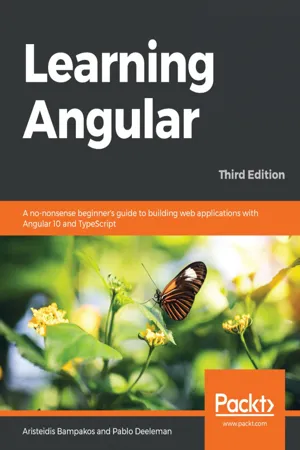
Learning Angular
A no-nonsense beginner's guide to building web applications with Angular 10 and TypeScript, 3rd Edition
Aristeidis Bampakos, Pablo Deeleman
- 430 Seiten
- English
- ePUB (handyfreundlich)
- Über iOS und Android verfügbar
Learning Angular
A no-nonsense beginner's guide to building web applications with Angular 10 and TypeScript, 3rd Edition
Aristeidis Bampakos, Pablo Deeleman
Über dieses Buch
Uncover Angular's potential for creating enterprise web applications—from setting up the environment to deployment—with the help of expert guidance, step-by-step explanations, and hands-on exercises
Key Features
- Learn the fundamentals of Angular to build web applications using TypeScript
- Explore the basics of Angular development, from components and templates to forms and services
- Discover best practices for building, packaging, and testing Angular applications
Book Description
Angular, loved by millions of web developers around the world, continues to be one of the top JavaScript frameworks thanks to its regular updates and new features that enable fast, cross-platform, and secure frontend web development. With Angular, you can achieve high performance using the latest web techniques and extensive integration with web tools and integrated development environments (IDEs).Updated to Angular 10, this third edition of the Learning Angular book covers new features and modern web development practices to address the current frontend web development landscape. If you are new to Angular, this book will give you a comprehensive introduction to help you get you up and running in no time. You'll learn how to develop apps by harnessing the power of the Angular command-line interface (CLI), write unit tests, style your apps by following the Material Design guidelines, and finally deploy them to a hosting provider. The book is especially useful for beginners to get to grips with the bare bones of the framework needed to start developing Angular apps.By the end of this book, you'll not only be able to create Angular applications with TypeScript from scratch but also enhance your coding skills with best practices.
What you will learn
- Use the Angular CLI to scaffold, build, and deploy a new Angular application
- Build components, the basic building blocks of an Angular application
- Discover techniques to make Angular components interact with each other
- Understand the different types of templates supported by Angular
- Create HTTP data services to access APIs and provide data to components
- Enhance your application's UX with Angular Material
- Apply best practices and coding conventions to your large-scale web development projects
Who this book is for
The Angular TypeScript book is for JavaScript and full-stack developers who want to enter the world of frontend development with Angular or migrate to the Angular framework to build professional web applications. Familiarity with web and programming concepts will assist with understanding the content covered in the book.
]]>
Häufig gestellte Fragen
Information
Section 1: Getting Started with Angular
- Chapter 1, Building Your First Angular App
- Chapter 2, Introduction to TypeScript
Chapter 1: Building Your First Angular App
- Semantic versioning, why it matters, and Angular's take on it
- How to set up an Angular project using Angular CLI 10
- How to use Angular CLI commands to accomplish certain tasks, such as building and serving an Angular app
- How to create our first application and begin to understand the core concepts in Angular
- The available tooling for Angular in popular IDEs
Technical requirements
- GitHub link: https://github.com/PacktPublishing/Learning-Angular--Third-Edition/tree/master/ch01
- Node.js: http://nodejs.org/
- Node Package Manager (npm): Included with Node.js
- Git: https://git-scm.com/downloads
- Visual Studio Code (VS Code): https://code.visualstudio.com/download
It's just Angular – introducing semantic versioning
Patch change
Minor change
Major change
What about Angular?
Introducing Angular
Inhaltsverzeichnis
- Learning Angular Third Edition
- Why subscribe?
- Preface
- Section 1: Getting Started with Angular
- Chapter 1: Building Your First Angular App
- Chapter 2: Introduction to TypeScript
- Section 2: Components – the Basic Building Blocks of an Angular App
- Chapter 3: Component Interaction and Inter-Communication
- Chapter 4: Enhance Components with Pipes and Directives
- Chapter 5: Structure an Angular App
- Chapter 6: Enrich Components with Asynchronous Data Services
- Section 3: User Experience and Testability
- Chapter 7: Navigate through Components with Routing
- Chapter 8: Orchestrating Validation Experiences in Forms
- Chapter 9: Introduction to Angular Material
- Chapter 10: Giving Motion to Components with Animations
- Chapter 11: Unit test an Angular App
- Section 4: Deployment and Practice
- Chapter 12: Bringing an Angular App to Production
- Chapter 13: Develop a Real-World Angular App
- Other Books You May Enjoy